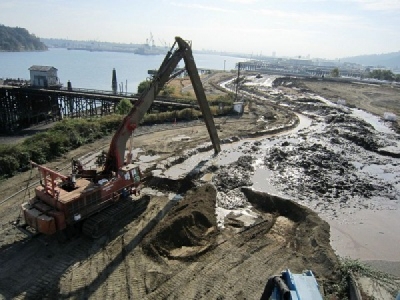
Posted on December 11, 2017
By Andrew Theen, OregonLive
The Portland Harbor Superfund, the contaminated 10-mile stretch of the Willamette River right through the heart of the Rose City, is one of 21 toxic areas the Trump administration says should see “immediate and intense” attention.
Cause for celebration?
From Gov. Kate Brown’s perspective, the announcement Friday can only be interpreted positively.
“We actually feel like there’s real momentum right now on the project,” said Bryan Hockaday, a spokesman for the governor.
But at least one longtime environmental advocate is not immediately convinced the list, released by Environmental Protection Agency administrator Scott Pruitt, is a reason to dance in the streets.
“If they truly mean that,” Bob Sallinger, the Audubon Society of Portland’s conservation director said of the agency’s top 21 list, “then that would be a good thing.”
But Sallinger said the environmental community and local interests who have long participated in and tracked the nearly two-decade slog to cleanup the dirty river, are still worried about the Trump administration’s environmental regulators.
Pruitt, in particular, made his career as Oklahoma’s attorney general by fighting the EPA and its mission to regulate and enforce environmental bad actors.
“We remain very concerned about how they have proceeded so far,” Sallinger said of the EPA and how it handled the Portland Harbor under Pruitt’s leadership.
It’s a good thing that the tribes and state are clued in, Sallinger said, but community groups are still left out of the process.
In October, environmental groups, the city and the Oregon Department of Environmental Quality sounded the alarm after it appeared the Trump-era EPA was negotiating behind closed doors with a select group of industrial polluters.
Former EPA officials in the regional headquarters in Seattle, and Oregon environmental leaders, said the new course was being directed by EPA leaders in Washington DC.
In January, the outgoing Obama administration EPA released a 2,535-page cleanup plan for the river site. The $1.05 billion plan would cleanup the river over the next 13 years, a hard-won compromise that environmental groups felt was a net win after a previous draft called for dredging fewer acres of toxic soil.
This October, it appeared to the state and environmental groups that the Pruitt-led EPA was preparing to unravel that agreement and looked to exclude state and local stakeholders.
The EPA later issued a statement saying it pledged to work with local stakeholders, including the state and tribal groups that had participated in the cleanup plan for 17 years.
But, Sallinger said the EPA is still negotiating on a new sampling plan for the river area with an unknown group of polluters.
“Transparency certainly hasn’t been resolved,” he said.
Hockaday, the governor’s spokesman, said the state is more optimistic that the EPA is working with everyone’s interests in mind.
Brown is particularly pleased, Hockaday said, that EPA’s regional administrator is visiting the Portland next week and the agency is expected to share its new river-sampling plan with the state and tribes sometime in the next week and a half.
“Once we get through this cleanup we’ll be able to activate all this additional riverfront property,” he said. Other responsible polluters, like Northwest Natural and the Port of Portland, are moving forward on independent cleanup plans for their properties.
The governor believes the parties are now negotiating in good faith, and transparently.
Just because Portland is on the list of superfund priority sites, an idea that came out of a task force created by Pruitt this summer, doesn’t mean the region will get more money or that the river is more polluted than other locations.
Pruitt, in a release, said the agency released its list as a way to take aim at important cleanup projects. Superfund, he said is now at “its rightful place at the center of the Agency’s mission.”
“Getting toxic land sites cleaned up and revitalized is of the utmost importance to the communities across the country that are affected by these sites,” he said in a statement.
Source: OregonLive





